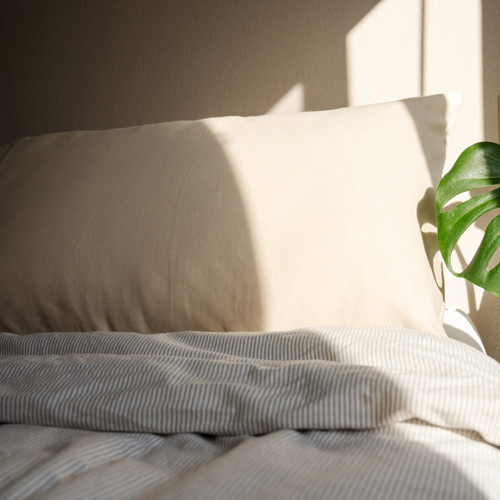Share:
Acne is a common skin condition that affects many people, but did you know that something as simple as your pillowcase could be contributing to your breakouts? Your pillowcase’s material can play a significant role in the development of acne, as it can trap oils, bacteria, and dirt from your skin and hair. In this blog post, we will explore the link between pillowcases and acne, and provide tips for choosing the right fabric to keep your skin clear and healthy.
The role of pillowcases in the development of acne:
Pillowcases can trap oils, bacteria, and dirt from your skin and hair, leading to breakouts. When you sleep, your skin is in contact with your pillowcase for several hours, which can cause substances to transfer from your skin and hair to the pillowcase. Over time, these can build up on the pillowcase, leading to clogged pores and breakouts. Additionally, when you move around during the night, the friction caused by your pillowcase against your skin can also lead to irritation and acne.
The best fabrics for preventing acne:
Choosing the right fabric for your pillowcase can make a big difference in preventing acne. Natural fibers like cotton, linen, and bamboo are breathable and absorbent, making them a good choice for acne-prone skin. These fabrics can help to absorb oils and sweat from your skin, which can help to prevent clogged pores and breakouts. Additionally, natural fibers are less likely to cause irritation.
Another fabric that is ideal for acne-prone skin is silk. Silk is a hypoallergenic fabric that is gentle on the skin, and it’s less likely to cause irritation or dryness. Silk pillowcases are also great for preventing wrinkles and frizzy hair.
How often to change your pillowcase:
Regularly changing your pillowcase is an important step in preventing acne. The build up on your pillowcase over time can lead to clogged pores and breakouts. The frequency at which you change your pillowcase will depend on the type of fabric you choose. For example, cotton and linen pillowcases should be changed every 1-2 weeks, while silk pillowcases can last up to 3-4 weeks before needing to be changed.
How to care for your pillowcase:
Caring for your pillowcase properly is important to ensure that it stays clean and fresh. It’s essential to wash your pillowcase frequently to remove oils, bacteria, and dirt that can build up over time. You should wash your pillowcases in warm water with a mild detergent, and it is best to avoid using bleach or fabric softeners. Drying your pillowcase properly is also important. If possible, air dry your pillowcase in the sun, as the UV rays can help to kill any bacteria or germs and prevent your pillowcase from wearing out.
The importance of a healthy sleep environment:
Maintaining a healthy sleep environment is important for overall skin health. In addition to choosing the right fabric for your pillowcase, other steps you can take to create a healthy sleep environment include keeping your bedding clean, maintaining proper ventilation, and controlling the temperature in your bedroom. A clean and well-ventilated bedroom can help to prevent the buildup of bacteria and mold, which can contribute to acne. Additionally, maintaining a comfortable temperature in your bedroom can help to prevent sweating and overheating, which also contribute to acne.
If you’re looking for an all natural, hypoallergenic pillowcase to prevent acne and provide you with a great night’s sleep, OURA’s pillowcase does it all.



